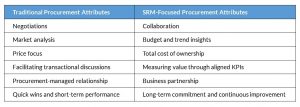Certain supplier relationships can be restraining – a supplier with whom negotiations are challenging and the ability to leverage volume or spend is limited, for example. Then, the question is “Without traditional leverage or any apparent substitute suppliers, how can procurement continue to drive value for the organization?” In many cases, the answer is to focus on longer-term supplier relationship management (SRM), not just immediate cost savings.
With an SRM approach, companies can convert difficult supplier relationships from a problem to a partnership. The process involves looking past the immediate price and cost savings to develop a supply chain collaboration and enhance the relationship between the supplier and the business, with benefits for both.
A Different Approach
SRM is a systematic approach that requires changes to key parts of the procurement process and deploys a methodology for enacting these changes. The table below highlights the difference between a traditional sourcing organization and one that deploys an SRM-based relationship model.

Getting to SRM
The first step in developing an SRM-based relationship model is supplier segmentation and scorecarding. Companies should identify their best and their most difficult suppliers, and create a scorecard for each. The scorecard should be dynamic and provide visibility into the relationship, tracking changes in the relationship over time.
With suppliers categorized, procurement should conduct a spend analysis on each. This provides insight and opens the door to a collaborative approach, which should be conducted with an enterprise spend in mind – a view many organizations have not broadly adopted. Accurate spend numbers and a view toward the total cost of ownership, vs. a one-time cost reduction, can provide longer-term benefits to both sides.
Next, procurement needs to develop a strong cadence for communication. Ask not only what the supplier can do for you, but what you can do to be their best customer. Changing the conversation from sourcing and negotiations to mutual value creation and growing together is a key attribute of an effective SRM program. Companies that successfully implement SRM-based relationships know that the key to long-term success is in being a preferred customer. The incentive for both parties to leverage an SRM model arises from its promise for growth and collaboration.
Executing on the SRM Model
Most people would probably agree that the approach described thus far is common sense. However, execution, change management and tracking progress is what makes the transformation actually happen. Companies should look to industry best practices to implement the approach successfully. For example, it is important to establish key performance indicators (KPIs) for both the supplier and the buyer and to conduct monthly or quarterly business reviews to assess performance against these metrics. KPIs create a level of accountability and trust, and reinforce that goals are aligned.
Timely meetings are crucial. To maintain ttrust, relationship meetings should address critical issues and ways to build the organizations together, focusing on long-term goals in addition to immediate performance. Honest communication, information sharing, listening to concerns and involving suppliers in the planning processes ultimately makes them a vested partner in the business and ensures their cooperation.
To achieve the objectives of an SRM model, organizations must also facilitate a program to take advantage of supplier innovations that drive sustainability and lean agility – the ability to respond to customers more quickly and over the long term. This is value that extends beyond price and immediate cost savings.
For many organizations, the move from traditional sourcing to an SRM model requires a certain level of expertise that may or may not exist within the procurement structure of the organization. Some key factors include:
- Supplier segmentation – applicable with both direct and indirect suppliers
- Metrics structure – savings and supplier benefits tracking
- Performance and risk management – assessing partnership suppliers
- Value creation and value mapping – defining and calculating value beyond price, i.e. quality, reliability, loyalty, speed, agility, risk, access to innovation, value-added services
- Change management – facilitating and driving discussion internally to ensure alignment with the SRM goal
- Training materials – SRM playbook, both internal and for the supplier
- Governance structure – SRM policies, procedures and relationship management cadence
In conclusion, transitioning to an SRM-based model requires an investment in resources, expertise and change management. This investment should be carefully aligned with concrete opportunities to create new value and/or better manage risk with suppliers. For value to be sustainable, the arrangement must be valued by both parties. Companies can motivate continuous improvements in supplier performance through a tight and transparent linking of performance to the suppliers’ share of spend. For their part, companies must acquire a set of skills that allows them to leverage suppliers’ ideas and expertise. These skills include the ability to communicate effectively and measure success with specific tools over an extended period. Methodically adopting and investing in these skills allows an organization to harness the win-win power of SRM for a real and sustained positive impact on the bottom line.
Greg Scharine, a Senior Consultant with Protiviti’s Supply Chain practice, contributed to this content.





